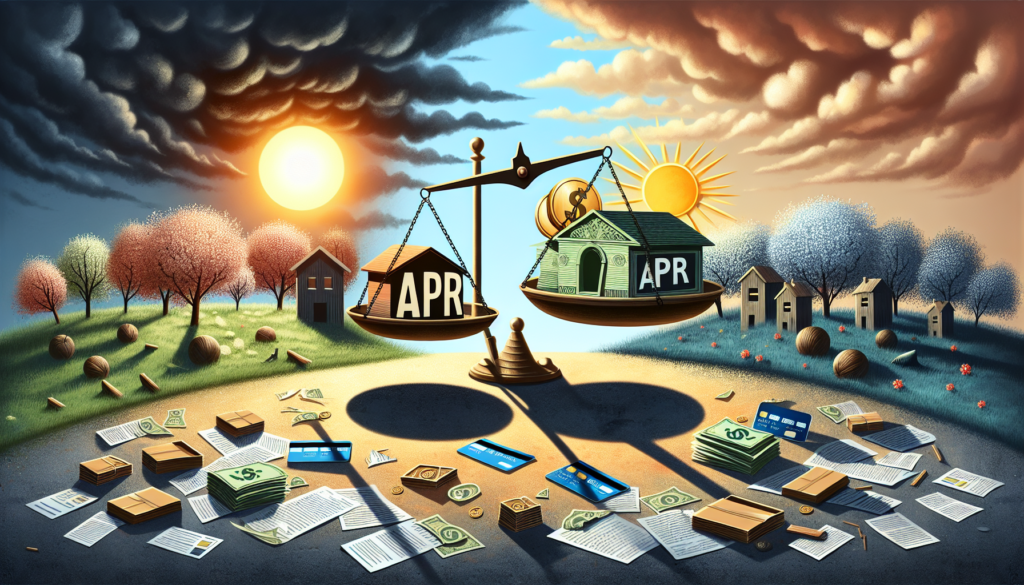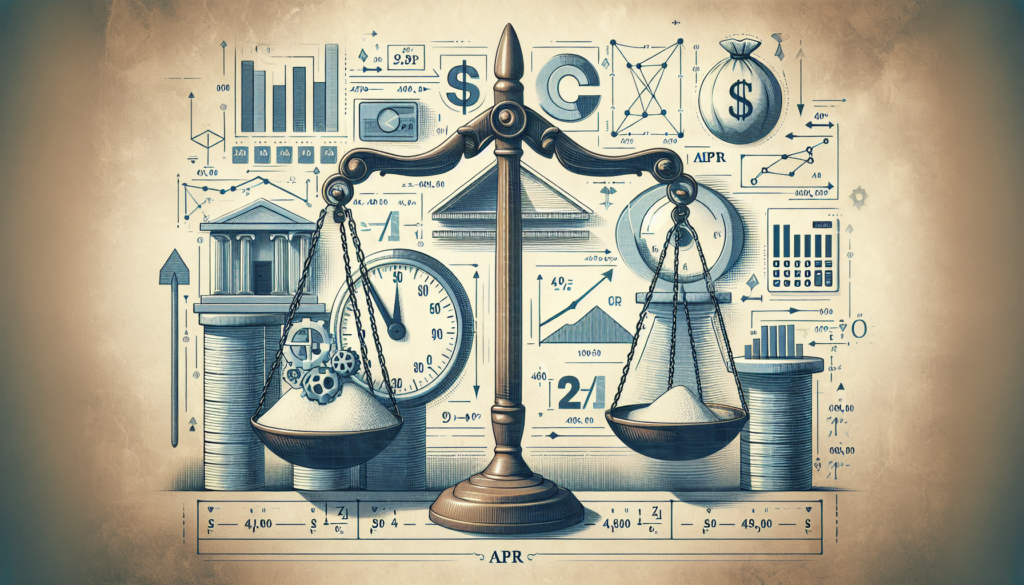In the world of finance, understanding key terms and concepts is crucial to making informed decisions. One such term is the Annual Percentage Rate, or APR. But what exactly does it mean? In simple terms, APR represents the total cost of borrowing, including both the interest rate and any applicable fees. By familiarizing yourself with APR, you can navigate the financial landscape with confidence and make smarter choices when it comes to loans, mortgages, and credit cards. So, let’s take a closer look at the ins and outs of Annual Percentage Rate.

Understanding Annual Percentage Rate (APR)
Definition of APR
Annual Percentage Rate (APR) is a crucial financial concept that represents the yearly cost of borrowing funds, expressed as a percentage. It includes the interest rate and additional fees or charges associated with borrowing. Unlike the interest rate, which only considers the cost of borrowing, the APR provides a broader picture of the total cost.
Importance of APR
The APR plays a significant role in the decision-making process when borrowing money. It allows you to compare different loan or credit options to determine the most cost-effective choice. By considering both the interest rate and associated fees, the APR provides a clearer understanding of the true cost of borrowing.
Components of APR
The components of APR consist of the interest rate, any upfront fees, and additional charges related to the borrowing arrangement. It is important to examine all the components to understand the total cost and make an informed decision.
Calculation of APR
Formula for APR Calculation
The calculation of APR depends on the specific terms and conditions of the loan. The general formula to calculate APR is:
APR = (Total Interest and Fees / Loan Amount) x (365 / Loan Term) x 100
This formula allows you to determine the annualized cost of borrowing, considering all associated expenses.
Including Fees and Charges in APR
To accurately calculate the APR, it is crucial to include all fees and charges associated with the loan. These may include origination fees, application fees, closing costs, and any other charges imposed by the lender. By including these expenses, the APR provides a holistic view of the actual cost of borrowing.
APR and Interest Rates
While closely related, APR and interest rates are not the same. The interest rate represents the cost of borrowing funds, expressed as a percentage. On the other hand, the APR incorporates the interest rate along with additional fees and charges. The APR provides a more comprehensive understanding of the total borrowing cost.

APR vs. Interest Rate
Differences Between APR and Interest Rate
The primary difference between APR and interest rate lies in their scope. The interest rate focuses solely on the cost of borrowing funds, while the APR takes into account the interest rate and any associated charges. The APR provides a more accurate depiction of the total cost of borrowing.
When to Use APR vs. Interest Rate
When comparing different loan or credit options, it is advisable to use the APR instead of the interest rate. The APR allows you to evaluate the true cost of borrowing by considering all associated fees. This empowers you to make informed decisions and choose the most cost-effective option.
APR in Different Financial Products
APR in Credit Cards
In credit cards, the APR represents the cost of borrowing funds through revolving credit. Higher APRs on credit cards generally indicate greater costs associated with borrowing. It is crucial to compare APRs when selecting a credit card to avoid unnecessary expenses.
APR in Mortgages
Mortgages often involve substantial amounts of money and lengthy repayment periods. The APR in mortgages reflects the total cost of borrowing, including closing costs and other fees. By considering the APR, you can evaluate the overall affordability of different mortgage options.
APR in Personal Loans
Personal loans typically come with fixed interest rates and repayment periods. The APR in personal loans incorporates any origination fees or administrative charges, allowing you to compare loans and select the most economical option.
APR in Auto Loans
When purchasing a vehicle, auto loans provide a convenient financing option. The APR in auto loans reflects the interest rate and any additional fees associated with the loan. Comparing APRs in auto loans helps you determine the most cost-effective way to finance your vehicle.

Impact of APR on Borrowing Costs
Higher APR and Higher Costs
A higher APR directly translates to higher borrowing costs. By carefully considering the APR, you can avoid unnecessary expenses and choose loans or credit options that offer the lowest overall costs.
Comparing APRs to Save Money
Comparing APRs across different loans or credit options allows you to identify the most affordable choice. By selecting options with lower APRs, you can save a significant amount of money on interest and fees over the duration of the loan.
Negotiating APR
In some cases, it might be possible to negotiate the APR with lenders, especially for personal loans or mortgages. It is worth discussing the APR and associated fees to explore potential opportunities for securing lower borrowing costs.
APR and Creditworthiness
Your creditworthiness plays a crucial role in the APR you are offered. Lenders consider factors such as credit score, employment history, and income level when determining the APR for a loan. Maintaining a good credit score and a positive credit history can help secure more favorable APRs.
Regulations and Disclosure Requirements
Consumer Protection Laws
Consumer protection laws enforce regulations to ensure fair practices by lenders and protect borrowers from predatory lending. These laws aim to prevent misleading information and ensure transparency in disclosing APRs and associated charges.
Truth in Lending Act
The Truth in Lending Act (TILA) is a federal law that requires lenders to provide accurate and transparent information about the terms and costs of loans. It mandates the disclosure of APRs, allowing borrowers to make informed decisions.
Required Disclosures for APR
Lenders are legally obligated to disclose the APR and associated fees to borrowers. This requirement ensures that borrowers have access to clear and comprehensive information for comparing loan options.

APR and Introductory Offers
Understanding Introductory APRs
Introductory APRs are promotional interest rates offered by lenders for a limited period. These rates are often lower than the regular APR and can be an attractive option for borrowers. However, it is important to consider the long-term implications once the introductory period ends.
Duration of Introductory APRs
The duration of introductory APRs varies depending on the lender and the specific terms of the offer. It is important to thoroughly understand the duration of the introductory period and the subsequent APR to gauge the long-term affordability.
Transitioning to Regular APR
Once the introductory period concludes, the APR transitions to the regular rate. It is essential to carefully assess the regular APR to ensure it is within your financial means.
APR and Balance Transfers
APR for Balance Transfer Offers
Balance transfer offers allow you to transfer existing credit card debt to another card with a lower APR. It is crucial to consider the APR on balance transfer offers to determine the potential savings and overall cost-effectiveness.
Introductory APRs for Balance Transfers
Balance transfer offers often come with introductory APRs, providing a temporary lower interest rate. Understanding the duration and subsequent APR is vital to assess the feasibility of the balance transfer option.
Fees and Charges in Balance Transfers
When considering balance transfers, it is important to consider any associated fees and charges, such as balance transfer fees. These additional costs contribute to the overall APR and should be carefully evaluated.
APR and Penalty APR
Definition of Penalty APR
Penalty APR is an increased interest rate imposed by lenders as a consequence of late or missed payments or other violations of the loan agreement. It is crucial to review the terms and conditions to understand the potential implications of penalty APRs.
Causes of Penalty APR
Penalty APRs are typically triggered by actions such as late payments, returned checks, or exceeding credit limits. Proper adherence to the loan terms and repayment schedule helps avoid the activation of penalty APRs.
Effects of Penalty APR
Penalty APRs significantly increase the cost of borrowing and can have a long-lasting impact. It is important to avoid triggering penalty APRs by fulfilling payment obligations and promptly addressing any issues.
Managing APR: Tips and Strategies
Improving Credit Score
Maintaining a good credit score can help secure more favorable APRs. By consistently paying bills on time, reducing debt, and managing credit responsibly, you can improve your creditworthiness and potentially access lower interest rates.
Comparing APRs
Comparing APRs across different loan or credit options is essential for making informed decisions. By evaluating the total cost of borrowing, including fees and charges, you can select the most affordable option.
Negotiating APRs
When applying for loans, especially personal loans or mortgages, it may be possible to negotiate the APR with lenders. It is advisable to discuss the APR and explore opportunities for securing lower interest rates, potentially saving on borrowing costs.
Paying Off Debt to Lower APR
Paying off existing debts can contribute to lowering your overall APR. By reducing outstanding balances or utilizing balance transfer options, you can potentially access lower interest rates and save on borrowing costs.
Understanding Annual Percentage Rate (APR) empowers you to make informed decisions when borrowing money. By considering all associated costs, such as interest rates and fees, the APR provides a comprehensive view of the true cost of borrowing. By comparing APRs, negotiating, and managing your credit responsibly, you can minimize your borrowing costs and make the most financially sound choices.


